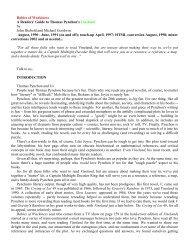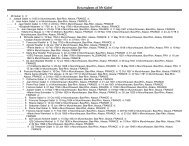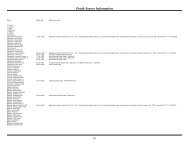CRC Handbook of Chemistry and Physics, 86th Edition
CRC Handbook of Chemistry and Physics, 86th Edition
CRC Handbook of Chemistry and Physics, 86th Edition
You also want an ePaper? Increase the reach of your titles
YUMPU automatically turns print PDFs into web optimized ePapers that Google loves.
The Elements 4-31<br />
material as it has a low electrical resistance, a low <strong>and</strong> stable<br />
contact resistance, <strong>and</strong> is highly resistant to corrosion. Plated<br />
rhodium, produced by electroplating or evaporation, is exceptionally<br />
hard <strong>and</strong> is used for optical instruments. It has a high<br />
reflectance <strong>and</strong> is hard <strong>and</strong> durable. Rhodium is also used for<br />
jewelry, for decoration, <strong>and</strong> as a catalyst. Fifty-two isotopes<br />
<strong>and</strong> isomers are now known. Rhodium metal (powder) costs<br />
about $180/g (99.9%).<br />
Rubidium — (L. rubidus, deepest red), Rb; at. wt. 85.4678(3); at.<br />
no. 37; m.p. 39.31°C; b.p. 688°C; sp. gr. (solid) 1.532 (20°C),<br />
(liquid) 1.475 (39°C); valence 1, 2, 3, 4. Discovered in 1861 by<br />
Bunsen <strong>and</strong> Kirch<strong>of</strong>f in the mineral lepidolite by use <strong>of</strong> the<br />
spectroscope. The element is much more abundant than was<br />
thought several years ago. It is now considered to be the 16th<br />
most abundant element in the earth’s crust. Rubidium occurs<br />
in pollucite, carnallite, leucite, <strong>and</strong> zinnwaldite, which<br />
contains traces up to 1%, in the form <strong>of</strong> the oxide. It is found<br />
in lepidolite to the extent <strong>of</strong> about 1.5%, <strong>and</strong> is recovered<br />
commercially from this source. Potassium minerals, such as<br />
those found at Searles Lake, California, <strong>and</strong> potassium chloride<br />
recovered from brines in Michigan also contain the element<br />
<strong>and</strong> are commercial sources. It is also found along with<br />
cesium in the extensive deposits <strong>of</strong> pollucite at Bernic Lake,<br />
Manitoba. Rubidium can be liquid at room temperature. It is<br />
a s<strong>of</strong>t, silvery-white metallic element <strong>of</strong> the alkali group <strong>and</strong><br />
is the second most electropositive <strong>and</strong> alkaline element. It ignites<br />
spontaneously in air <strong>and</strong> reacts violently in water, setting<br />
fire to the liberated hydrogen. As with other alkali metals,<br />
it forms amalgams with mercury <strong>and</strong> it alloys with gold,<br />
cesium, sodium, <strong>and</strong> potassium. It colors a flame yellowish<br />
violet. Rubidium metal can be prepared by reducing rubidium<br />
chloride with calcium, <strong>and</strong> by a number <strong>of</strong> other methods. It<br />
must be kept under a dry mineral oil or in a vacuum or inert<br />
atmosphere. Thirty five isotopes <strong>and</strong> isomers <strong>of</strong> rubidium are<br />
known. Naturally occurring rubidium is made <strong>of</strong> two isotopes,<br />
85 Rb <strong>and</strong> 87 Rb. Rubidium-87 is present to the extent <strong>of</strong> 27.83%<br />
in natural rubidium <strong>and</strong> is a beta emitter with a half-life <strong>of</strong> 4.9<br />
× 10 10 years. Ordinary rubidium is sufficiently radioactive to<br />
expose a photographic film in about 30 to 60 days. Rubidium<br />
forms four oxides: Rb 2 O, Rb 2 O 2 , Rb 2 O 3 , Rb 2 O 4 . Because rubidium<br />
can be easily ionized, it has been considered for use in<br />
“ion engines” for space vehicles; however, cesium is somewhat<br />
more efficient for this purpose. It is also proposed for use as<br />
a working fluid for vapor turbines <strong>and</strong> for use in a thermoelectric<br />
generator using the magnetohydrodynamic principle<br />
where rubidium ions are formed by heat at high temperature<br />
<strong>and</strong> passed through a magnetic field. These conduct electricity<br />
<strong>and</strong> act like an armature <strong>of</strong> a generator thereby generating<br />
an electric current. Rubidium is used as a getter in vacuum<br />
tubes <strong>and</strong> as a photocell component. It has been used in making<br />
special glasses. RbAg 4 I 5 is important, as it has the highest<br />
room conductivity <strong>of</strong> any known ionic crystal. At 20°C its<br />
conductivity is about the same as dilute sulfuric acid. This<br />
suggests use in thin film batteries <strong>and</strong> other applications. The<br />
present cost in small quantities is about $50/g (99.8% pure).<br />
Ruthenium — (L. Ruthenia, Russia), Ru; at. wt. 101.07(2); at. no.<br />
44, m.p. 2334°C; b.p. 4150°C; sp. gr. 12.41 (20°C); valence 0,<br />
1, 2, 3, 4, 5, 6, 7, 8. Berzelius <strong>and</strong> Osann in 1827 examined<br />
the residues left after dissolving crude platinum from the Ural<br />
mountains in aqua regia. While Berzelius found no unusual<br />
metals, Osann thought he found three new metals, one <strong>of</strong><br />
which he named ruthenium. In 1844 Klaus, generally recog-<br />
nized as the discoverer, showed that Osann’s ruthenium oxide<br />
was very impure <strong>and</strong> that it contained a new metal. Klaus<br />
obtained 6 g <strong>of</strong> ruthenium from the portion <strong>of</strong> crude platinum<br />
that is insoluble in aqua regia. A member <strong>of</strong> the platinum<br />
group, ruthenium occurs native with other members <strong>of</strong><br />
the group in ores found in the Ural mountains <strong>and</strong> in North<br />
<strong>and</strong> South America. It is also found along with other platinum<br />
metals in small but commercial quantities in pentl<strong>and</strong>ite <strong>of</strong><br />
the Sudbury, Ontario, nickel-mining region, <strong>and</strong> in pyroxinite<br />
deposits <strong>of</strong> South Africa. Natural ruthenium contains seven<br />
isotopes. Twenty-eight other isotopes <strong>and</strong> isomers are known,<br />
all <strong>of</strong> which are radioactive. The metal is isolated commercially<br />
by a complex chemical process, the final stage <strong>of</strong> which<br />
is the hydrogen reduction <strong>of</strong> ammonium ruthenium chloride,<br />
which yields a powder. The powder is consolidated by powder<br />
metallurgy techniques or by argon-arc welding. Ruthenium is<br />
a hard, white metal <strong>and</strong> has four crystal modifications. It does<br />
not tarnish at room temperatures, but oxidizes in air at about<br />
800°C. The metal is not attacked by hot or cold acids or aqua<br />
regia, but when potassium chlorate is added to the solution,<br />
it oxidizes explosively. It is attacked by halogens, hydroxides,<br />
etc. Ruthenium can be plated by electrodeposition or by thermal<br />
decomposition methods. The metal is one <strong>of</strong> the most effective<br />
hardeners for platinum <strong>and</strong> palladium, <strong>and</strong> is alloyed<br />
with these metals to make electrical contacts for severe wear<br />
resistance. A ruthenium-molybdenum alloy is said to be superconductive<br />
at 10.6 K. The corrosion resistance <strong>of</strong> titanium<br />
is improved a hundredfold by addition <strong>of</strong> 0.1% ruthenium. It is<br />
a versatile catalyst. Hydrogen sulfide can be split catalytically<br />
by light using an aqueous suspension <strong>of</strong> CdS particles loaded<br />
with ruthenium dioxide. It is thought this may have application<br />
to removal <strong>of</strong> H 2 S from oil refining <strong>and</strong> other industrial<br />
processes. Compounds in at least eight oxidation states have<br />
been found, but <strong>of</strong> these, the +2. +3. <strong>and</strong> +4 states are the<br />
most common. Ruthenium tetroxide, like osmium tetroxide,<br />
is highly toxic. In addition, it may explode. Ruthenium compounds<br />
show a marked resemblance to those <strong>of</strong> osmium. The<br />
metal is priced at about $25/g (99.95% pure).<br />
Rutherfordium — (Ernest Rutherford [1871–1937], New Zeal<strong>and</strong>,<br />
Canadian, <strong>and</strong> British physicist); Rf; at. wt. [261]; at. no. 104.<br />
In 1964, workers <strong>of</strong> the Joint Nuclear Research Institute at<br />
Dubna (Russia) bombarded plutonium with accelerated 113<br />
to 115 MeV neon ions. By measuring fission tracks in a special<br />
glass with a microscope, they detected an isotope that decays<br />
by spontaneous fission. They suggested that this isotope,<br />
which has a half-life <strong>of</strong> 0.3 ± 0.1 s, might be 260 104, produced<br />
by the following reaction:<br />
242<br />
94<br />
260<br />
Pu + Ne → 104 + 4n<br />
22<br />
10<br />
Element 104, the first transactinide element, is expected to<br />
have chemical properties similar to those <strong>of</strong> hafnium. It would,<br />
for example, form a relatively volatile compound with chlorine<br />
(a tetrachloride). The Soviet scientists have performed experiments<br />
aimed at chemical identification, <strong>and</strong> have attempted<br />
to show that the 0.3-s activity is more volatile than that <strong>of</strong> the<br />
relatively nonvolatile actinide trichlorides. This experiment<br />
does not fulfill the test <strong>of</strong> chemically separating the new element<br />
from all others, but it provides important evidence for<br />
evaluation. New data, reportedly issued by Soviet scientists,<br />
have reduced the half-life <strong>of</strong> the isotope they worked with<br />
from 0.3 to 0.15 s. The Dubna scientists suggest the name<br />
kurchatovium <strong>and</strong> symbol Ku for Element 104, in honor <strong>of</strong>







